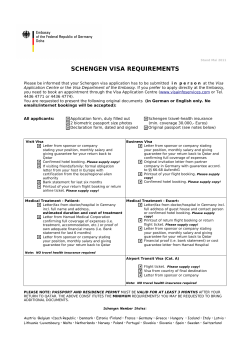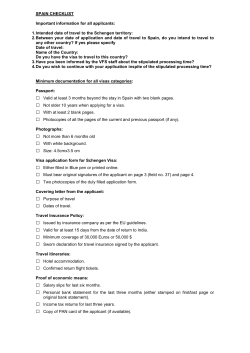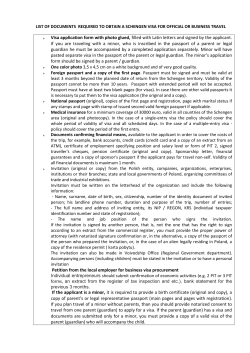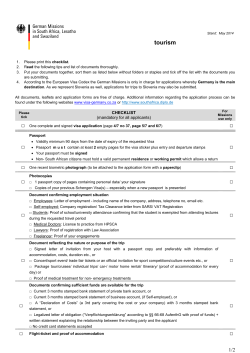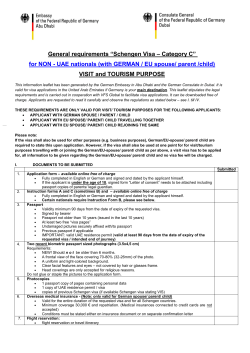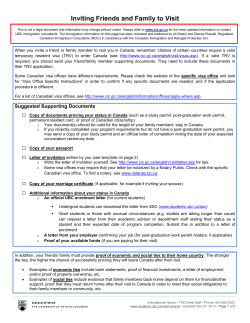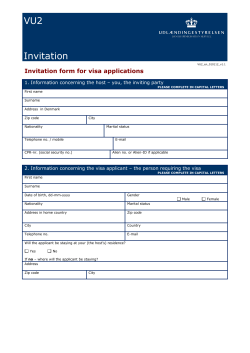
The Positive Effects of the Schengen Agreement on European Trade 1 Dane Davis
The Positive Effects of the Schengen Agreement on European Trade1 Dane Davis CRU Group Thomas Gift Department of Political Science Duke University Forthcoming at The World Economy Abstract: Enacted in 1985, the Schengen Agreement is widely heralded as both a symbol and major institutional advancement of the European project. By eliminating passport requirements for workers, the compact ostensibly produces gains from travel, ease of market access, and economies of scale. Yet despite these optimistic predictions, scholars know little about the actual effects of Schengen on trade. We fill this void by identifying why labor mobility should expand the cross-country exchange of goods and services and then test our theory with data from Europe spanning the period 1980 to 2011. We argue that labor mobility resulting from Schengen yields positive effects on trade by increasing demand for foreign goods, improving awareness of low-cost producers abroad, and lowering the risks associated with buying and selling outside the country. Using the gravity model of trade, we show empirically that Schengen membership makes European states more robust trading partners. Introduction ers the world over had high hopes that a unified European market would produce gains from travel, ease of market access, and economies of scale. Yet while Schengen has undoubtedly become a vivid symbol of the European project—representing solidarity and harmony between nations—what impact has it really had on regional economic integration? Our article constitutes an original attempt to shed light on how Schengen affects trade on the continent. We argue that the immigration policies established by Schengen promote cross-border commerce for three central reasons. First, immigrants bring a preference for goods specific to the country from which they emigrated, thereby raising demand for familiar products. Second, immigrants have the potential to recognize the savings from trade because of their knowledge of foreign low-cost producers. Finally, immigrants are plugged into social networks that lower the risks of importing and exporting. Employing the well-established gravity model of trade, we show that migratory flows stemming from Schengen are positively and significantly related to cross-national exchanges in goods and services over the period 1980 to 2011. We find that the effects of Schengen on European trade are considerable in substantive terms. When two countries are members of Schengen, total trade between them increases by approximately .10 percent every year. Furthermore, a net increase of immigrants from one country to another by just 1 percent annually can expand trade between those two nations by an almost equivalent amount. When Along the banks of the River Moselle in Luxembourg on June 14th, 1985, European leaders signed the Schengen Agreement, an unprecedented step in the drive toward continental integration. Supplemented by the 1990 Convention Implementing the Schengen Agreement, the compact promised a new era of cooperation among European states in a variety of policy areas, most noticeably in regional border control. In particular, it created the eponymous Schengen Area, a 4.3 million square kilometer area that eliminated passport requirements for cross-country European travel and work. Today, the more than 400 million citizens residing within the 26 member nations of the Schengen Agreement can visit, work, and live in any other member state without restriction. When originally conceived, Schengen was billed not only as a crucial step for regional border control, but also as a major advancement in the goal of creating a single European polity. Predating the European Union by eight years, the zone was to be instrumental in erecting the first large-scale international labor market. In addition, the fluidity of labor enshrined by Schengen was heralded as the perfect complement to the free movement of capital and goods implemented by previous treaties. Lead1 Gift gratefully acknowledges financial support from the National Science Foundation Graduate Research Fellowship Program. Contact: dane.davis@crugroup.com / thomas.gift@duke.edu. 1 viewed in the context of overall trade, this can make a large imprint on the amount of cross-border commercial transactions that take place throughout Europe. For example, trade totals between Italy and Spain amounted to nearly $53 billion in 2011. Accordingly, a growth of .10 percent in this figure would generate more than $50 million worth of extra trade between these states every year. Our article’s main finding—that the world’s largest free labor compact has a positive influence on European integration through trade—is germane to both academics and policymakers. It advances the ongoing scholarly debate over the nature of the relationship between labor mobility and factor endowments, including trade in product and service markets. Given the growing prominence of regional, integrative organizations throughout the globe, it also has salient implications for states considering joining Schengen or other similarly styled compacts. In the wake of a global financial crisis that has left the European Union teetering on the brink of collapse, it is particularly timely to probe the forces that may help save—or ultimately shatter—the largest experiment of pooled national sovereignty in history. The rest of our article proceeds in six sections. Section I puts Schengen in historical context and discusses its intended objectives. Section II reviews the relevant economics literatures on the link between labor mobility and trade. Section III presents our theory for why immigration stemming from Schengen should have a positive influence on economic integration in Europe by expanding transnational trade. Section IV outlines the research design and empirical models. Section V highlights the key findings and applies a series of robustness checks that gauge the explanatory power of our analysis. Section VI concludes, offers an agenda for future research, and derives implications for EU integration in the coming years. halting unregulated labor mobility. World War II and its aftermath left Europe divided, with travel— let alone labor mobility—nearly impossible between East and West. Cross-country labor mobility, however, was not a complete anomaly during much of the mid- to late twentieth century. Prior to the enactment of Schengen, there were several smaller-scale attempts to construct a liberalized labor mobility regime. Belgium, the Netherlands, and Luxembourg, for instance, devised a novel plan in 1948 to eliminate border controls among the three countries. This effort was followed in 1952 by the formation of the Nordic Passport Union, which permitted free travel and eliminated border controls among Denmark, Sweden, Iceland, Norway, and Finland. The predecessor to the European Union, the European Economic Community, also partially vouchsafed the free movement of labor in the 1957 Treaty of Rome. But it was not until 1985, when France, West Germany, and the three members of the Benelux Economic Union debated, drafted—and ultimately signed—the Schengen Agreement, that labor mobility truly took hold in contemporary Europe. The treaty, which represented a sea change in how workers traveled in Europe, was not only confined to eliminating border controls, but also covered a variety of related fields, such as common agreements on security, police, and personal identification data. The 1997 Treaty of Amsterdam would later subsume the Schengen Agreement into the European Union’s acquis communautaire, meaning that all member states of the EU, with the exception of the United Kingdom and Ireland, were obligated to implement the compact. Today, Schengen is widely regarded as the quintessence of European collaboration. The director-general for research of the European Parliament has hailed Schengen as “the most notable example of multilateral immigration policy harmonisation” (EU 1997). Kinga Goncz, former prime minister of Hungary, has similarly declared that “besides the euro, Schengen is the most im1 Historical Context portant acquis of the European Union.... [F]or Although early data on European population flows many people, it is the most visible sign of the exisare limited, evidence suggests that from the 1800s tence of the European Union” (European Parliato the mid-1900s, it was relatively easy for citizens ment 2011).1 Yet despite its undoubted imporon the continent to travel from one country to an- tance, remarkably little is known about the actual other. The main driver of labor mobility then, as impact of increased migration flows on European now, was the search for gainful employment. The First World War, however, abruptly ended this situ1 Not everyone is so enamored with unimpeded travel ation of laissez-faire labor mobility. Fear of foreign within Europe. One British MP, for example, has scathingly spies and other looming security concerns led to raised the prospect that “the Schengen agreement represents ambition of the hard core of the European Union to more stringent border control. Meetings in 1920, the do away with internal frontiers” and thus any semblance of 1926, and 1927 by the League of Nations formal- sovereignty at the nation-state level (United Kingdom Parized the issuance of passports and visas, effectively liament 1995). 2 cohesion. In particular, how does Shengen affect European economic integration through trade? country’s exports and a .14 percent increase for the host country’s imports given a 1 percent boost in immigrant stock. 2 What distinguishes our study from prior research is its focus on how a particular freedom of labor compact—the Schengen Agreement—affects the link between worker flows and trade in Europe. As far as we are aware, no existing study has examined how a large-scale free labor compact influences trade across member and non-member countries over time. We argue that labor mobility between states, all other things equal, should produce a net rise in trade. A region that trades more constitutes a more integrated economic market. In the following section, we outline why migration resulting from Schengen should have positive effects on integration. Using data encompassing all major European nations from 1980 to 2011, we then test our hypotheses using the gravity model of trade. Limitations of Existing Literature Over the past two decades, a burgeoning economics literature has examined the link between immigration and trade. These studies can be broadly lumped into three groups, based on their scope and units of analysis. The first group explores how domestic labor flows affect trade among a country’s political or economic subunits, such as states, provinces, or other local jurisdictions (e.g., Bardhan and Guhathakutra 2004; Dunlevy 2006; Wagner, Head, and Ries 2002). Scholars have conducted several such analyses in advanced industrialized economies, including the United States, Canada, and Spain. In general, results suggest that immigration has a positive effect on trade. Yet these analyses raise concerns of external validity. Factors like a similar culture or low transportation costs may not apply across countries, making it hard to generalize about migration-trade linkages to other parts of the world. A second group of studies investigates the impact of bilateral trade flows of a single host country (e.g., Helliwell 1997; Ching and Chen 2000). Specifically, these studies focus on how labor flows from the immigrant’s origin country to the host country affect trade patterns between the selected nations. This research again shows that the effect of labor flows on trade tends to be positive and statistically significant. Such analyses, however, are also subject to questions that they do not demonstrate how immigration and trade are connected across a larger sample of countries. If there is something unique about the host country being investigated, the positive relationship between people flows and trade may not hold across a large set of nations or regions. The last group of studies—and which most closely resembles our analysis—investigates the link between trade and people flows among multiple host countries using panel data (e.g., Dolman 2008; Lewer 2006; Konecny 2007). This research, which provides an international view of how immigration influences the volume and direction of trade, concentrates largely on the OECD and other wealthy market economies. To the best of our knowledge, however, only Parsons (2005) measures the impact of labor mobility on trade exclusively within the European context. His work, comprising the EU15 and the EU-15 expansion countries from 1994 to 2004, finds a .12 percent increase for the host 3 Theory We hypothesize that continental worker flows emanating from Schengen should increase trade in Europe for three central reasons. 3.1 Tastes and Preferences The first is the tastes and preferences that migrants bring for goods unique to their home country (e.g., Dunlevy and Hutchinson 1999; White 2007). All nations specialize in certain products and services, many of which reflect the cultural, topographical, or historical characteristics of their society. Moreover, many of these countries have specific brands or geographic-specific versions of said products. For example, French workers living in Germany may demand Bordeaux wines, while German workers residing in France may desire Frankfurt sausages. If immigrants cannot find perfect (or even suitable) substitutes, one of two outcomes is likely. First, expatriates will import these items. This practice has become increasingly common in recent decades with the rise of the Internet. The second is that new businesses will either form or relocate that cater to these workers. Sometimes, these products proliferate and become mainstream, so it is not just (or even primarily) expatriates who purchase them. In either case, such burgeoning demand for foreign goods should expand trade. 3 3.2 Awareness of Low-cost Produc- 4 ers Abroad Research Design Below, we present our research design to examine The next reason why increased migration in Eu- the influence of Schengen on European trade. rope should bolster trade is that foreign workers possess privileged information about low-cost pro- 4.1 Case Selection ducers abroad (e.g., Bryant, Genc, and Law 2004; Girma and Yu 2002; Gould 1994). When opening a All major countries that might reasonably be conconfines of Europe are business or working for a corporation, immigrants sidered in the geographic 2 represented in our study. This includes EU memcan use this knowledge by patronizing companies in ber states, so-called EU “fast-track” nations, and their homeland. Imagine, for instance, an Italianother countries that could conceivably be slated for born tailor living in Spain, who knows of a boutique future EU membership. By extending the universe Milan-based company from which to buy low-cost, of cases beyond the Schengen Zone, we can exploit high-quality linens. By patronizing this company, variation in compact membership while still focusthe tailor will save money on the wholesale price ing on Europe as the unit of analysis. In total, and boost sales by passing savings onto consumers. we include 36 countries in our empirics, spanning This process can also work in reverse. If an immigrant finds that his or her host country has better the years 1980 to 2011, for which comparable data or lower cost producers of certain products, then were available: Albania, Austria, Belgium, Bosnia, the immigrant can take advantage of this arbitrage Bulgaria, Croatia, Cyprus, Czech Republic, Denby exporting goods to his or her home country. The mark, Estonia, Finland, France, Germany, Greece, Hungary, Iceland, Ireland, Italy, Latvia, Lithuaresult will again be expanded trade. nia, Luxembourg, Macedonia, Malta, Montenegro, Netherlands, Norway, Poland, Portugal, Romania, Serbia, Slovakia, Slovenia, Spain, Sweden, Switzer3.3 Minimizing Risks of Trade land, and the United Kingdom. Finally, we predict that migration in Europe will positively affect trade because foreign workers lower the risks associated with buying and selling abroad (e.g., Rauch and Trindade 2002; Tadesse and White 2008). This occurs in three ways. First, immigrants who seek out products from their home country generally do so because they believe in the reliability of a product. This makes them more inclined to buy goods from outside their country. Second, trading in a foreign country necessitates trust not just in the product or good, but also in the suppliers or consumers. Negotiating cross-border contracts is inherently risky, and foreign-born employees may reduce barriers that dissuade companies from penetrating international markets. Third, immigrants are often better positioned to negotiate with foreign producers. Because workers remain plugged into social networks in their native country, they can pressure foreign producers if they renege on contracts. This makes buying from producers abroad less of a gamble and increases trade. 3.4 4.2 Dependent Variable Our dependent variable is bilateral trade flows in a given year among country dyads. This is computed as the sum of freight on board imports and exports, measured in constant US dollars. In addition to looking at aggregate trade flows, we also unpack this variable into its two constituent parts: 1) imports from country i to country j ; and 2) exports from country i to country j. This enables us to examine whether our theory holds for all types of trade, just imports, just exports, or none of the above.3 Data on trade come from the International Monetary Fund’s Direction of Trade Statistics. 2 We exclude a number of small countries because of data constraints. 3 Previous studies reveal that the causes of trade may operate differently depending on whether the dependent variable is imports or exports, since immigrants often affect one market but not the other (e.g., Girma and Yu 2002). Consider, for instance, a scenario whereby the host country for an immigrant group produces mainly commodities and their source country produces primarily consumer goods, with little importation of unfinished products. We would expect, based on these patterns, for the immigrant group to have a larger impact on imports to the host country than exports from the origin nation. Main Hypothesis • Increased labor flows between countries resulting from the Schengen Agreement should strengthen trade, and hence, bolster European economic integration. 4 4.3 Key Independent Variables N etExportsijt = f (GDPit , GDPjt , Distanceij ) We have two main independent variables. The first is whether both countries in a dyad are members of the Schengen Agreement. We code a dyad as “1” if both nations are members and “0” otherwise. A total of 26 nations within Europe are now part of Schengen.4 Our second independent variable is total migration, which comes from Eurostat and measures immigration to the host country based on the immigrant’s citizenship.5 The migration variable represents the actual amount of people flows from one country to another, while the Schengen variable captures the opportunity for workers to change domiciles. where N etImportsijt constitutes country i ’s imports from j in year t and N etExportsijt denotes country i ’s exports from j in year t. In each case, GDP should be positively related to overall trade, imports, and exports, since larger and wealthier countries produce more goods and services to trade and also have populations that demand more items from abroad. Distance should be negatively related, since trading across long distances is inconvenient and raises transportation costs. For many years, economists generally estimated gravity models via a log-log ordinary least squares regression. In such a setup, a unit percentage change in the independent variables is associated with a unit percentage change in trade. The basic estimator can be written as: 4.4 Methodological Considerations We employ the gravity model of trade to assess the relationship between our independent and dependent variables. The gravity model dates back more than 50 years (Tinbergen 1962), but it remains one of the most effective tools for analyzing the causes of imports and exports between countries.6 The intuition behind this model is simple: Trade between two nations is chiefly determined by their geographic space apart (i.e., distance) and relative economic masses (i.e., national incomes). Additional independent and control regressors can then be added to isolate the causes of cross-country trade. The most basic specification of the gravity model is: ln(N etT radeijt ) = B0 + ln(B1 (GDPit )) + ln(B2 (GDPjt )) + ln(B3 (Distanceij )) + E But recent scholarship shows this strategy introduces two problems: 1) “Jensen’s inequality” (i.e., in estimating ln(N etT radeijt ), the expected value of the natural log of a random variable 6= the natural log of its expected value), which biases estimates amid heteroskedasticity; 2) the existence of zero values on the dependent variable, which are undefined as logs. Following the advice of Silva and Tenyro (2006), most economists now estimate a multiplicative discrete probability distribution model with a Poisson pseudo-maximum likelihood estimator (PPML). This estimator, first derived by Gourieroux, Monfort, and Trogon (1984), solves the challenge of modeling zero trade flows and overcomes Jensen’s inequality by obviating the need for logging the dependent variable.7 This specification can be expressed as: N etT radeijt = f (GDPit , GDPjt , Distanceij ) where N etT radeijt denotes country i ’s net trade totals from country j in year t; GDPit and GDPjt are the total national incomes of countries i and j, respectively, in year t (measured in constant US dollars); and Distanceij is the distance (measured in kilometers) between the countries’ capital cities. Net trade can also be disaggregated into imports and exports: N etT radeijt = exp[B0 + ln(B1 (GDPit )) + ln(B2 (GDPjt )) + ln(B3 (Distanceij ))] + E N etImportsijt = f (GDPit , GDPjt , Distanceij ) In recent years, scholars have proffered many alternatives to the PPML (e.g., gamma pseudocountries are: Austria, Belgium, Czech Republic, Denmark, Estonia, Finland, France, Germany, Greece, maximum-likelihood (GPML), nonlinear least 4 These Hungary, Iceland, Italy, Latvia, Liechtenstein, Lithuania, Luxembourg, Malta, Netherlands, Norway, Poland, Portugal, Slovakia, Slovenia, Spain, Sweden, Switzerland. 5 While our theory bears more on worker flows specifically, rather than migration flows generally, there do not exist—as far as we know—harmonized data on labor mobility for European countries over an extended period of time. For a discussion of data limitations on European immigration, see Raymer, de Beer, and van der Erf (2011). 6 For reviews of the gravity model, see Anderson (2011) and Leamer and Levinsohn (1995). 7 One notable challenge comes from Martin and Pham (2008), who argue that PPML estimators still suffer from some bias in the presence of zero trade flows. Yet this is only problematic if the dependent variable has an extremely large number of zeroes, which should not occur in our data of all European countries. In the official trade data, we identify what appears to be occassionally inconsistent reporting between zeros and missing data (e.g., jumps from zero trade flows one year to large trade figures the next). To minimize such problems, we code all zeros as missing. 5 of cheese, retailers in each nation would have an incentive to buy from domestic producers, thereby reducing trade. squares (NLS) estimator, feasible generalized least squares (FGLS), etc.).8 Yet as far as we are aware, most operate effectively only under very narrow circumstances or perform at roughly the same level as the PPML in terms of minimizing bias. Thus, we concur with Silva and Tereyo’s contention that PPML “has all the characteristics needed to make it a promising workhorse for the estimation of gravity equations and, more generally, constant elasticity models” (Include citation). To improve confidence in our regressions, we employ the PPML estimator. For robustness checks, however, we also reestimate all of our full models using OLS. One advantage of this approach is that the coefficient parameters are directly interpretable, since the underlying model is linear. For consistency with prior studies that do not employ MLE techniques, the OLS regressions also provide a point of reference for comparing the magnitude of each coefficient. We append to all the models our two key independent variables: 1) whether both countries in a trade dyad are signatories to the Schengen Agreement; and 2) total migration flows. We also include two other explanatory variables, which have been robustly linked to cross-national trade. The first control is a binary variable for whether two nations are geographically adjacent. Direct proximity should increase trade by facilitating special partnerships between countries that share borders. Due to their distance, we would expect, for instance, Croatia and Slovenia, whose capital cities are just 118 kilometers away (about a 90 minute drive), to trade more than Cyprus and Iceland, whose capital cities are 4,778 kilometers apart (a several hour plane ride, across both continental Europe and the North and Norwegian Seas). But we may also expect these countries to trade more because sharing a border often implies having increased diplomatic and commercial linkages. We also include a dichotomous variable for whether both nations in a dyad have a common official language. On the one hand, this may boost trade if two countries with similar ethno-linguistic traits enjoy enhanced social and economic relations. For example, both Germany and Austria share the German language, so the ties between their populations may be especially strong. On the other hand, if such countries already produce similar products, this variable may be negatively related to trade since there exists less opportunity to capitalize on comparative advantage. If, for instance, two French-speaking countries already produce a surfeit 4.5 Empirical Model The final specification of our gravity model, including both the independent and control variables, is the poisson estimation of: N etT radeijt = exp[B0 + ln(B1 (GDPit )) + ln(B2 (GDPjt )) + ln(B3 (Distanceij )) + ln(B4 (Immigrationijt )) + B5 (Schengenij ) + B6 (Adjacentij ) + B7 (CommonLanguageij ) + E 5 Results and Discussion (Table 1 about here) (Table 2 about here) (Table 3 about here) (Table 4 about here) We begin by testing whether cross-country immigration and membership in Schengen affect overall trade within country dyads. Models 1-5 of Table 1 present the results of the PPML regressions, introducing the controls in stepwise fashion. We find strong support for our theory that people flows have a statistically significant and positive effect on trade. In addition, when two countries are both signatories to Schengen, they trade more. These results hold in both Models 2 and 3, which include geographic distance and economic mass as the control variables. They remain significant in Model 5, the full regression with all the explanatory regressors. The coefficients on both Immigration and Schengen suggest that these effects are nontrivial in economic terms, with elasticities of .09 and .14, respectively. Models 8-12 of Table 2 reestimate our main models using OLS regression. Consistent with our expectations, country dyads where both states belong to Schengen and which possess higher immigrant flows enjoy more trade. The elasticities mirror those from the PPML regressions. According to Model 12, which includes all the controls, a 1 percent increase in immigration between two countries increases their bilateral trade by .10 percent. Moreover, when two countries are members of Schengen, the net trade between country i and country j is on average .09 percent higher per year. Such a figure 8 For a summary of alternative approaches, see Martinezhas large economic significance. For example, trade Zarzoso (2013). totals between Germany and France amounted to 6 $231 billion in 2011, so a .09 percent increase in this 5.1 Additional Robustness Checks figure would equate to almost $208 million worth of additional trade between these two countries every To ensure that our findings are not partially a funcyear. tion of some specific qualities underlying our data Next, we see whether immigration and mutual (i.e., violations of i.i.d. assumptions, unit heteromembership in Schengen influence imports, not just geneity, and/or omitted variable bias), we apply total trade, within country dyads. Models 14-18 of several robustness checks to our models. First, we Table 3 summarize our PPML regressions, again reestimate all of our main linear estimations with a adding the control variables in stepwise order. The non-parametric bootstrapping method (Models 13, positive and significant coefficients on both Immi- 26, 39). Following a Monte Carlo approach, we gration and Schengen suggest that labor flows are treat the sample as a population and then, based associated with greater imports between country i on 500 replications, randomly resample from the and country j. This finding holds in the baseline re- observed data with replacement. Because each of gressions, Models 15 and 16, which only include the the samples is unique, the simulations allow us to people flows and Schengen variables, as well as ge- see how the standard errors vary where standard ographic distance and GDP. In the regression with distributional assumptions might not hold (Efron all the controls, Model 18, the elasticity on Immi- and Tibshirani 1993). We find that the coefficients gration is .09, while for Schengen it is .15. The and their significance levels closely conform to those directions and magnitudes of these effects are sim- in our original regressions. ilar to those regressions that employ overall trade We also apply spatial and temporal fixed effects as the dependent variable. to our main PPML models to account for unobserved unit heterogeneity in our data. While our control variables are standard in gravity models of trade, omitted variables owing to the particular circumstances of a nation or time period could still skew our results. Country fixed effects, for instance, might pick up specific properties of states that affect trade, such as tariffs, subsidies, or geographical constraints (e.g., landlocked status, etc.). Year fixed effects may control for time sensitive factors, such as macroeconomic upturns and downturns, exogenous shocks (e.g., natural disasters, etc.), and the diffusion of treaties dealing with European integration. In no instance do our primary results change after controlling for either country (Models 6, 19, 32) or temporal (Models 7, 20, 33) fixed Finally, we investigate exports. As demonstrated effects. by Models 27-31 of Table 5, both Immigration and Finally, we employ a lagged dependent variable Schengen are positive and statistically significant in all our PPML models (results not shown). While in the PPML regressions. In the regression with it is a matter of debate in the literature, some scholall the controls, Model 31, the coefficient is .09 on ars suggest that failing to do so might cause errors Immigration and .14 on Schengen. As seen in Mod- when countries exhibit irregular trading patterns els 34-38 of Table 6, these results are similar using due to factors not explicitly captured by the model OLS. According to the main regression, Model 38, (e.g., Eichengreen and Irwin 1996). Others sugwhen both countries in a dyad are signatories to gest that lagging the dependent variable may unSchengen, exports rise by an average of .14 per- duly inflate the size of the coefficients because it cent. Furthermore, a 1 percent rise in immigration permits immigration to affect trade in two ways: is associated with a .11 percent increase in exports. directly (through immigration’s effect on trade in To put this in context, in 2011, the total exports the current year), and indirectly (by influencing from France to Spain totaled roughly $44 billion. trade in the past, which influences trade in the A .11 percent growth in this amount would ex- present) (e.g., Wagner, Head, and Ries 2002). Uspand French exports by about $48 million annually. ing a lagged dependent variable, we discover no subTaken collectively, our results suggest that Schen- stantive differences in the signs and significance of gen, and the immigration that it promotes, have Immigration or Schengen on overall trade, imports, positive and sizeable impacts on European trade. or exports. We then reestimate our import regressions using OLS in Models 21-25 of Table 4. While Immigration stays positive and significant in all of the regressions, we discover a slight difference when it comes to Schengen. The complete model, Model 25, indicates that, controlling for other factors, Schengen has a positive, yet not statistically significant, impact on trade. By comparison, when looking at actual immigration, and not just the potential for migrating via Schengen, the impact is large and statistically significant. Specifically, a 1 percent jump in immigration is linked to a .09 percent increase in imports. This aligns with our hypothesis that countries that promote greater exchanges of people also reap gains from imports. 7 6 Concluding Remarks also made clear in the explicit rejection of European political integration within the stated platforms of many of these parties. Immigration might also trigger resentment in migration donor states through “brain drain” of educated and talented workers away from feeble domestic markets. The loss of a state’s most productive citizens can adversely affect economic activity in that country, resulting in losses to innovation and international competitiveness. The size and extent of this phenomenon is a topic of considerable research, and questions linger about the magnitude of its actual impact within Europe. But to the degree that it does occur, there is reason to suspect that free flows of labor promoted by Schengen may fuel backlash among poorer European nations that lag behind in human-capital-intensive jobs. In short, labor mobility supported by Schengen should yield both hope and caution for European observers. Hope, because our results indicate that increasing cross-national labor mobility can fuel trade and economic growth. Europe, then, has a possible source for relieving its current economic malaise. Caution, because there are many other factors besides trade that matter for regional integration. These realities suggest a need for tempered claims when it comes to how Schengen will shape the future trajectory and long-term viability of the EU. It also highlights the necessity of probing more deeply the varied, and perhaps cross-cutting, repercussions of Schengen. Only by tackling the issue from multiple angles will scholars gain a more complete profile of how immigration affects Europe’s future. Our paper began by asking a simple question: What are the effects of labor mobility stemming from the Schengen Agreement on European trade? Building on insights from international economics, we hypothesized that the fluid movement of migrants within Europe should bolster trade for three central reasons: It shifts out the demand curve for foreign goods by consumers, informs retailers about low-cost producers abroad, and enables firms to hedge their risks associated with buying and selling outside the country. Using the gravity model, we showed that labor mobility enhances trade, all other things equal. Over the whole of Europe, this boost in immigration results in hundreds of millions of dollars of increased trade every year. Our study represents an initial attempt to quantify the effects of Schengen on trade and also contributes to a burgeoning literature regarding the impacts of labor mobility on cross-border commerce. Given the battery of factors that shape trade within Europe, we are hesitant to offer bold policy implications from our findings. Still, at a time when many have predicted a future end-game for the EU, it is worth highlighting how one aspect of European policy seems to be binding the continent closer together. For advocates of the European project, as well as policymakers concerned about what the demise of the EU would mean for monetary stability and the economic balance of power, this news should prove encouraging. Of course, just as our results can be seen as a boon for Schengen and prospects for the further “deepening and widening” of modern Europe, it is important to underscore that our results only speak to one aspect of regional integration. Looking ahead, it may well prove fruitful to explore how Schengen influences other dimensions of integration, including political support for pooled sovereignty via supranational institutions. After all, just because Schengen brings the continent closer together economically, it does not necessarily follow that labor mobility will lead to the automatic integration of the EU from a political vantage, as well. Indeed, the two might not go hand-in-hand. One reason to be wary is that labor mobility tends to harden domestic attitudes toward immigration in general and often leads native workers to perceive that foreigners are poaching scarce domestic jobs. These mindsets might affect preferences for political parties, shifting the partisan center of gravity to the right. Anecdotal evidence of this can be observed through a groundswell in the election of far-right political parties, which increasingly oppose the concentration of power in Brussels. It is 8 7 References Racism.” Directorate-General for Research. Working document. Public Liberties Series LIBE 102 Anderson, James E. 2011. “The Gravity Model.” EN. Annual Review of Economics 3(1): 133-160. Girma, Sourafel, and Zhihao Yu. 2002. “The Bardhan, Ashok D., and Subhrajit Guhathakurta. Link between Immigration and Trade: Evidence 2004. “Global Linkages of Subnational Regions: from the United Kingdom.” Weltwirtschaftliches Coastal Exports and International Networks.” Archiv 138(1): 115-130. Contemporary Economic Policy 22(2): 225-236. Gould, David M. 1994. “Immigrant Links to Bryant, John Robert, Murat Genc, and David Law. the Home Country: Empirical Implications for 2004. “Trade and Migration to New Zealand.” U.S. Bilateral Trade Flows.” Review of Economics and Statistics 76(2): 302. New Zealand Treasury Working Paper. Gourieroux, C., A. Monfort, and A. TROGNON. 1984. “Pseudo Maximum Likelihood Methods: Theory.” emphEconometrica 52(3): 681. Ching, Hsianghoo S., and Li-Lu Chen. 2000. “Links between Emigrants and the Home Country: The Case of Trade between Taiwan and China.” In Regional Cohesion and Competition in the Age of Globalization. Eds. Hirotada Kohno, Peter Nijkamp, and Jacques Poot. Cheltenham, UK: Edward Elgar. Harden, Jeffrey J. 2011. “A Bootstrap Method for Conducting Statistical Inference with Clustered Data.” State Politics & Policy Quarterly 11(2): 223-246. Dolman, Ben. 2008. “Migration, Trade and “National Borders, Investment.” Australian Government Productivity Helliwell, John F. 1997. Trade and Migration.” Pacific Economic Review Commission Staff Working Paper. Canberra. 3(3): 165-185. Dunlevy, James A. 2006. “The Impact of Corruption and Language on the Pro-trade Effect of Konecny, Tomas 2007. “Can Immigrants Hurt Immigrants: Evidence from the American States.” Trade?” CERGEI-EI Working Paper Series 329. Review of Economics and Statistics 88(1): 182-186. Leamer Edward E., and James Levinsohn. 1995. Dunlevy, James A., and William K. Hutchin- “International Trade Theory: The Evidence.” In son. 1999. “The Impact of Immigration on Handbook of International Economics, Vol. 3. American Import Trade in the Late Nineteenth Eds. Gene M. Grossman and Kenneth Rogoff. and Early Twentieth Centuries.” Journal of Eco- Amsterdam: Elsevier Sci. B.V. nomic History 59(4): 1043-1062. Lewer, Joshua J. 2006. “The Impact of ImEfron, Bradley, and Robert Tibshirani. 1993. migration on Bilateral Trade: OECD Results An Introduction to the Bootstrap. Boca Raton, from 1991-2000.” Southwestern Economic Review. 33(1): 9-22. FL: CRC Press. Martin, Will, and Cong S. Pham. 2008. “Estimating the Gravity Model When Zero Trade Flows Are Frequent.” Deakin University, Australia. Mimeo. Eichengreen, Barry and Douglas A. Irwin (1997). “The Role of History in Bilateral Trade Flows.” In The Regionalization of the World Economy. Ed. Jeffrey A. Frankel. Chicago: University of Chicago Press. Martinez-Zarzoso, Inmaculada. 2013. “The Log of Gravity Revisited.” Applied Economics 45(3): 311-327. European Parliament. 2011. “Changes to Schengen (Debate).” Available at http://www.euro parl.europa.eu/sides/getDoc.do?pubRef=//EP//TEXT+CRE+20110706+ITEM-017+DO C+XML+V0//EN Gourieroux, C. A., A. Monfort, A. Trogon. 1984. Pseudo maximum likelihood methods: Applications. Econometrica. 52: 701-720. European Union. 1997. “European Union Rauch, James E., and Vitor Trindade. 2002. Anti-Discrimination Policy: From Equal Oppor- “Ethnic Chinese Networks in International Trade.” tunities between Women and Men to Combating Review of Economics and Statistics 84(1): 116-130. 9 Raymer, James, Joop de Beer, and Rob van der Erf. 2011. “Putting the Pieces of the Puzzle Together: Age and Sex-Specific Estimates of Migration amongst Countries in the EU/EFTA, 2002-2007.” European Journal of Population 27(2): 185-215. Silva, J.M.C. Santos and Silvana Tenreyro, 2009. “Further Simulation Evidence on the Performance of the Poisson Pseudo-maximum Likelihood Estimator.” Economics Discussion Papers 666, University of Essex, Department of Economics. Silva, J. M. C. Santos, and Silvana Tenreyro. 2006. “The Log of Gravity.” Review of Economics and Statistics 88(4): 641-658. Tadesse, Bedassa, and Roger White. 2011. “Emigrant Effects on Trade: Re-examining the Immigrant-trade Link from the Home Country Perspective.” Eastern Economic Journal 37(2): 281-302. Tinbergen, Jan. 1962. Shaping the World Economy: Suggestions for an International Economic Policy. New York: Twentieth Century Fund. United Kingdom Parliament. 1995. Transcript of the House of Commons. March 9. Available at http://www.publications.parliament.uk/pa /cm199495/cmhansrd/1995-03-09/Orals-1.html Wagner, Don, Keith Head, and John Ries. 2002. “Immigration and the Trade of Provinces.” Scottish Journal of Political Economy 49(5): 507-525. White, Roger. 2007. ”Immigrant-Trade Links, Transplanted Home Bias and Network Effects.” Applied Economics 39(7-9): 839-852. 10 8 Tables Table 1: Effect of Immigration and Schengen on Trade: PPML Models loggdpreali loggdprealj logdistance Model 1 Model 2 Model 3 Model 4 Model 5 Model 6 Country FE Model 7 Year FE 0.800*** (0.004) 0.803*** (0.004) -1.219*** (0.010) 0.766*** (0.010) 0.764*** (0.007) -1.151*** (0.016) 0.078*** (0.007) 0.750*** (0.010) 0.749*** (0.007) -1.122*** (0.015) 0.087*** (0.007) 0.143*** (0.018) 0.750*** (0.010) 0.749*** (0.007) -1.120*** (0.019) 0.086*** (0.007) 0.143*** (0.018) 0.004 (0.027) -11.749*** (0.169) 0.921 25360 -10.813*** (0.312) 0.926 8204 -10.326*** (0.309) 0.931 8204 -10.333*** (0.317) 0.931 8204 0.748*** (0.009) 0.748*** (0.007) -1.126*** (0.020) 0.088*** (0.007) 0.141*** (0.019) 0.006 (0.027) -0.031 (0.035) -10.241*** (0.308) 0.931 8204 0.304*** (0 .025) 0.756*** (0 .006) - 1.088*** (0 .020) 0.131*** (0 .008) 0.170*** (0 .016) - 0.034* (0 .021) 0.209*** (0 .026) 1.189* (0 .631) 0.956 8204 0.763*** (0.009) 0.768*** (0.007) -1.144*** (0.019) 0.077*** (0.006) 0.199*** (0.017) -0.027 (0.024) -0.006 (0.032) -11.167*** (0.299) 0.941 8204 logimmigrationij schengen adjacent officiallanguage cons r2 N * p < 0.10; ** p < 0.05; *** p < 0.01 (two-tailed test) Standard errors are given in parentheses 11 Table 2: Effect of Immigration and Schengen on Trade: OLS Models loggdpreali loggdprealj logdistance Model 8 Model 9 Model 10 Model 11 Model 12 0.911*** (0.004) 0.890*** (0.004) -1.400*** (0.011) 0.794*** (0.008) 0.878*** (0.006) -1.393*** (0.016) 0.102*** (0.006) 0.785*** (0.008) 0.868*** (0.006) -1.389*** (0.016) 0.104*** (0.006) 0.103*** (0.022) 0.789*** (0.008) 0.868*** (0.006) -1.317*** (0.019) 0.098*** (0.006) 0.092*** (0.022) 0.289*** (0.040) -15.941*** (0.157) 0.854 25360 -13.235*** (0.268) 0.879 8204 -12.847*** (0.280) 0.880 8204 -13.432*** (0.291) 0.880 8204 0.789*** (0.008) 0.869*** (0.006) -1.323*** (0.019) 0.099*** (0.006) 0.094*** (0.022) 0.330*** (0.042) -0.206*** (0.053) -13.408*** (0.291) 0.881 8204 logimmigrationij schengen adjacent officiallanguage cons r2 N * p < 0.10; ** p < 0.05; *** p < 0.01 (two-tailed test) Standard errors are given in parentheses 12 Model 13 Bootstrap 0.789*** (0 .010) 0.869*** (0 .007) - 1.323*** (0 .020) 0.099*** (0 .006) 0.094*** (0 .018) 0.330*** (0 .036) -0.206*** (0 .053) -1 3.408*** (0 .378) 0.881 820 4 Table 3: Effect of Immigration and Schengen on Imports: PPML Models loggdpreali loggdprealj logdistance Model 14 Model 15 Model 16 Model 17 Model 18 Model 19 Country FE Model 20 Year FE 0.790*** (0.005) 0.807*** (0.005) -1.206*** (0.013) 0.753*** (0.013) 0.769*** (0.009) -1.138*** (0.020) 0.079*** (0.009) 0.738*** (0.013) 0.754*** (0.009) -1.108*** (0.019) 0.087*** (0.009) 0.142*** (0.022) 0.739*** (0.013) 0.754*** (0.009) -1.116*** (0.026) 0.088*** (0.009) 0.144*** (0.023) -0.013 (0.037) -12.385*** (0.204) 0.888 25635 -11.447*** (0.422) 0.885 8219 -10.964*** (0.415) 0.890 8219 -10.937*** (0.427) 0.890 8219 0.740*** (0.012) 0.754*** (0.009) -1.110*** (0.025) 0.087*** (0.009) 0.146*** (0.023) -0.016 (0.037) 0.029 (0.038) -11.026*** (0.403) 0.891 8219 0.247*** (0 .032) 0.774*** (0 .008) - 1.229*** (0 .027) 0.121*** (0 .010) 0.237*** (0 .021) - 0.131*** (0 .027) 0.196*** (0 .033) 2.593*** (0 .809) 0.922 821 9 0.756*** (0.012) 0.774*** (0.009) -1.129*** (0.025) 0.076*** (0.009) 0.209*** (0.023) -0.050 (0.034) 0.054 (0.036) -11.544*** (0.393) 0.900 8219 logimmigrationij schengen adjacent officiallanguage cons r2 N * p < 0.10; ** p < 0.05; *** p < 0.01 (two-tailed test) Standard errors are given in parentheses 13 Table 4: Effect of Immigration and Schengen on Imports: OLS Models loggdpreali loggdprealj logdistance Model 21 Model 22 Model 23 Model 24 Model 25 0.866*** (0.004) 1.045*** (0.004) -1.426*** (0.013) 0.771*** (0.011) 1.047*** (0.008) -1.479*** (0.022) 0.099*** (0.008) 0.767*** (0.011) 1.043*** (0.008) -1.477*** (0.023) 0.100*** (0.008) 0.042 (0.031) 0.772*** (0.011) 1.042*** (0.008) -1.398*** (0.027) 0.093*** (0.008) 0.030 (0.031) 0.320*** (0.056) -19.414*** (0.194) 0.811 25635 -17.306*** (0.373) 0.819 8219 -17.149*** (0.391) 0.819 8219 -17.803*** (0.407) 0.819 8219 0.771*** (0.011) 1.043*** (0.008) -1.403*** (0.027) 0.094*** (0.008) 0.031 (0.031) 0.353*** (0.058) -0.166** (0.074) -17.783*** (0.407) 0.819 8219 logimmigrationij schengen adjacent officiallanguage cons r2 N * p < 0.10; ** p < 0.05; *** p < 0.01 (two-tailed test) Standard errors are given in parentheses 14 Model 26 Bootstrap 0.771*** (0 .013) 1.043*** (0 .010) - 1.403*** (0 .025) 0.094*** (0 .008) 0.031 (0 .026) 0.353*** (0 .047) -0.166** (0 .064) -1 7.783*** (0 .475) 0.819 821 9 Table 5: Effect of Immigration and Schengen on Exports: PPML Models loggdpreali loggdprealj logdistance Model 27 Model 28 Model 29 Model 30 Model 31 Model 32 Country FE Model 33 Year FE 0.811*** (0.005) 0.798*** (0.005) -1.231*** (0.013) 0.777*** (0.011) 0.760*** (0.008) -1.164*** (0.021) 0.077*** (0.007) 0.761*** (0.011) 0.744*** (0.008) -1.134*** (0.021) 0.086*** (0.007) 0.144*** (0.024) 0.760*** (0.011) 0.744*** (0.009) -1.123*** (0.025) 0.085*** (0.007) 0.142*** (0.024) 0.019 (0.028) -12.508*** (0.216) 0.885 25519 -11.563*** (0.350) 0.891 8217 -11.070*** (0.365) 0.895 8217 -11.108*** (0.357) 0.895 8217 0.756*** (0.011) 0.743*** (0.008) -1.141*** (0.027) 0.088*** (0.007) 0.136*** (0.024) 0.026 (0.027) -0.087** (0.044) -10.856*** (0.349) 0.895 8217 0.355*** (0 .029) 0.741*** (0 .007) - 0.963*** (0 .024) 0.139*** (0 .008) 0.110*** (0 .019) 0.056*** (0 .020) 0.222*** (0 .030) - 1.501** (0 .755) 0.949 821 7 0.770*** (0.011) 0.762*** (0.008) -1.157*** (0.026) 0.078*** (0.006) 0.190*** (0.024) -0.005 (0.025) -0.062 (0.041) -11.768*** (0.336) 0.906 8217 logimmigrationij schengen adjacent officiallanguage cons r2 N * p < 0.10; ** p < 0.05; *** p < 0.01 (two-tailed test) Standard errors are given in parentheses 15 Table 6: Effect of Immigration and Schengen on Exports: OLS Models loggdpreali loggdprealj logdistance Model 34 Model 35 Model 36 Model 37 Model 38 1.085*** (0.005) 0.841*** (0.005) -1.510*** (0.014) 0.902*** (0.009) 0.818*** (0.007) -1.490*** (0.019) 0.105*** (0.007) 0.890*** (0.009) 0.804*** (0.007) -1.484*** (0.019) 0.108*** (0.007) 0.149*** (0.026) 0.892*** (0.009) 0.804*** (0.007) -1.438*** (0.022) 0.104*** (0.007) 0.142*** (0.026) 0.183*** (0.047) -19.232*** (0.201) 0.805 25519 -14.550*** (0.309) 0.852 8217 -13.989*** (0.323) 0.853 8217 -14.359*** (0.336) 0.853 8217 0.892*** (0.009) 0.805*** (0.007) -1.447*** (0.022) 0.106*** (0.007) 0.144*** (0.026) 0.240*** (0.048) -0.284*** (0.061) -14.325*** (0.336) 0.853 8217 logimmigrationij schengen adjacent officiallanguage cons r2 N * p < 0.10; ** p < 0.05; *** p < 0.01 (two-tailed test) Standard errors are given in parentheses 16 Model 39 Bootstrap 0.892*** (0 .011) 0.805*** (0 .007) - 1.447*** (0 .025) 0.106*** (0 .007) 0.144*** (0 .023) 0.240*** (0 .040) -0.284*** (0 .061) -1 4.325*** (0 .396) 0.853 821 7
© Copyright 2025

